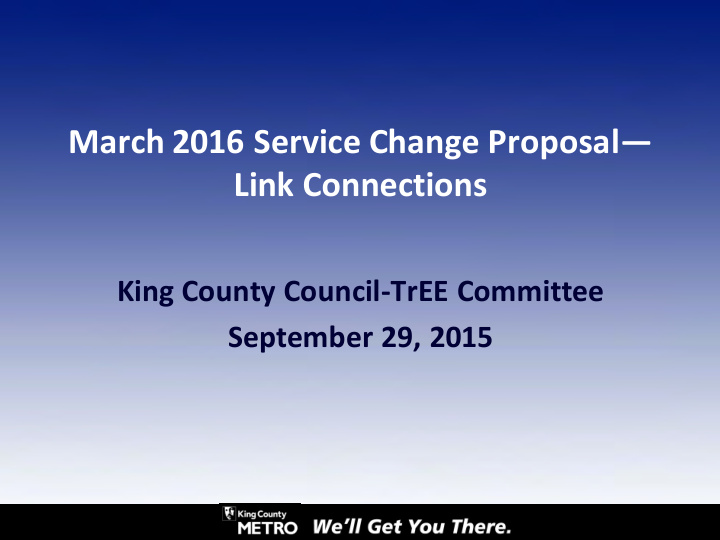



March 2016 Service Change Proposal — Link Connections King County Council-TrEE Committee September 29, 2015
Sound Transit’s University Link Extension A catalyst, but not the sole reason for change Fast Frequent Reliable High Capacity 2
Metro's Service Restructures and ST Integration Maximize the public tax dollar New Sound Transit Services 1999 Service Integration Motion - Three counties agree to modify bus service in response to new Sound Transit service 1995 to Present NE Seattle and Capitol Hill have seen little change in service structure over many decades. Most other areas of King County have seen service route restructures of similar scope and scale. 3
Service Guidelines - Restructures "Under all circumstances...service restructures shall have a goal to:" focus service frequency on the highest ridership create convenient opportunities for transfer connections between services match service capacity to ridership demand increase ridership Service will be designed for convenient transfers and travel time penalties should be minimized a maximum walk distance goal of 1/4 mile 4
Community Engagement Proposal evolved in response to public input over three phases 16,000 comments and survey responses shaped the final proposal Proposal development aided by Sounding Board of community members who ride transit Riders want better frequency, better reliability and new connections Tradeoff – some riders want to add choices AND maintain historic travel patterns 5
Fare Payment Seamless transfer between bus and rail using ORCA or ORCA L IFT Partnering with Sound Transit on outreach to increase availability and educate riders Distributing free cards, advertising, ORCA to Go, s treet teaming, In Motion Bus service between downtown Seattle and U District will continue to be available 6
Proposal Overview More peak-period service More frequent bus service to 80,000 daily riders Slower and less reliable service between U District and Downtown Seattle replaced by Link Resources reinvested to improve frequency Bus connection options to downtown Seattle remain Improved reliability by shortening routes and providing connecting riders to Link Adds new connections to South Lake Union and between NE Seattle, Fremont and downtown Proposal includes Seattle’s Prop 1 investments 7
Peak Period Service • More bus service to key employer destinations • Maintains fast connections to Downtown Seattle • Provides new, fast connections to • South Lake Union • First Hill • Most peak commuter routes bypass U District and use I-5 reversible lanes 8
New Connections New east-west connection between neighborhoods in NW and NE Seattle (Route 62) New/improved connections to SLU/First Hill ( r outes 63 and 64) 9
New East-West Connections: Route 62
New East-West Connections: Route 62
New East-West Connections: Route 62
New East-West Connections: Route 62
New East-West Connections: Route 62
New East-West Connections: Route 62
New East-West Connections: Route 62
New East-West Connections: Route 62 To/from Downtown Seattle
New Connections to South Lake Union and First Hill 18
Improved Reliability Buses on time = Riders on time • Reinvests resources to split two long and unreliable cross-town routes • Provides improved connections to Link 19
Frequency Improvements – NE Seattle Households with access to 15 Minute Mid-day Service • Current Network: 8,700 20
Frequency Improvements – NE Seattle Households with access to 15 Minute Mid-day Service • Current Network: 8,700 • Proposed Network: 28,000 Triples the number of households with access to service every 15 minutes or better all-day 21
Frequency Improvements – Capitol Hill Households with access to 12 Minute Mid-day Service • Current Network: 15,600 22
Frequency Improvements – Capitol Hill Households with access to 12 Minute Mid-day Service • Current Network: 15,600 • Proposed Network: 40,000 More than doubles the number of households with access to service every 12 minutes or better all-day 23
Proposed Options for Current Route 71 Riders Route 71 will be replaced by… Link light rail Expanded peak period service on Route 76 More frequent service on intersecting north-south corridors More frequent east-west service on NE 65 th Street 30-minute service in View Ridge 24
25
26
27
28
29
Current Route 71 riders that will have access to frequent, all- day service to the University District within ¼ mile of an existing stop: 94 % 30
Peak Commuter Options for Current Route 71 Riders Peak Commuter Routes will provide fast connections to: • Downtown Seattle • South Lake Union • First Hill Recommended Service Levels Daily Bus Trips AM Peak PM Peak Route 64 7 8 74 11 11 76 16 15 373 8 9 * Green indicates an increase 31
Proposed Options for Current Route 43 Riders Route 43 will be replaced by… Link light rail Added service on Route 48 More frequent east-west service in John/Thomas corridor (Routes 8 and 11) Frequent service in Pike/Pine corridor (Routes 10, 11, 47 and 49) 32
Route 43
Route 43 and Link Light Rail
Route 48
Route 8 Route 11
Route 10 Route 47 Route 49
All-Day Route Network
All-Day Route Network with Frequency Current Route 43 riders that will have access to frequent, all- day service within ¼ mile of an existing stop: 100 %
Sounding Board Recommendation The resulting system, as proposed, is by far more logical and more useful than our current system. …Metro’s final restructuring proposal delivers more reliability and frequency, enabling more people both to commute and take spontaneous trips without the need of a car. 40
Transfer Environment – UW Station Montlake Triangle rebuilt to improve pedestrian travel 2005 2015 41
Transfer Environment – UW Station 42
Helping with the Transition ORCA To-Go Street Teaming Rider Information – printed and online In Motion 43
What will these changes mean for you? Check out changes by area Check out changes by route Check out changes using an interactive map Call 206-477-3835 or email deanna.martin@kingcounty.gov 44
Recommend
More recommend